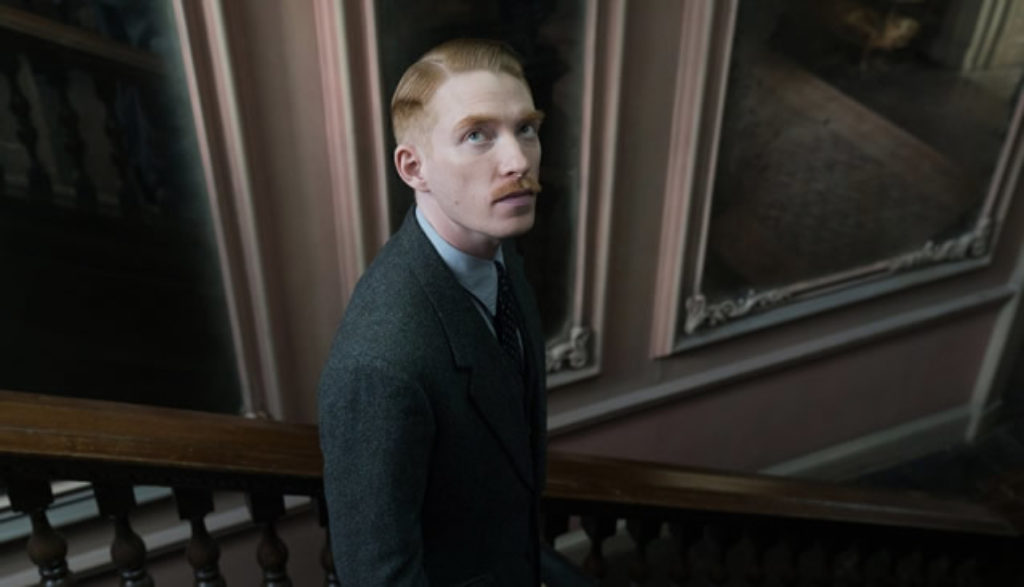
Hundreds Hall has stood for a hundred years or more. Every brick could tell a story, every shred of wallpaper could sing a history.
But bricks crumble, wallpaper curls and history itself sours. As British culture heaves and roils in the aftermath of World War II, the Ayres family, which has lived in Hundreds since its cornerstone was first set, has slipped into titled poverty. The proud house still stands, but shadowed by its old glory, bleached by trial and time.
Dr. Faraday remembers the house in its heyday, from a beloved fete in 1919. He was just a boy then, given a medal in honor of the end of the First World War, as well as sweets to the point of bursting. He, of all the village children, was granted access to the house itself. (Faraday’s mother was a one-time servant there.) He walked by a frame covered in plastered sculpture—three-dimensional leaves and acorns swirling like tactile magic. He broke an acorn off, as if to pocket a hint of that magic for himself. The deed, and memory, have haunted him ever since.
Now an adult, Faraday’s called back to Hundreds to treat the sick servant Betty, and he sees how far the house has fallen.
It doesn’t take long for Faraday to diagnose the maid: She’s not so much sick as she is terrified and imaginative, feeling an unseen, inexplicable presence in the house. In fairness to the girl, Hundreds could scare anyone when the lights go out.
The house stands nearly empty now, unless you count the mice in the walls and sparrows in the rafters. Once employing perhaps dozens of servants, the Ayres family has just Betty these days—barely much more than a girl. Roderick Ayres, the house’s titular master, is hardly much help to her. He returned from the war bearing horrific scars, both physical and mental. Worrying about Hundreds’ crippling expenses saps whatever energy Roderick might still have. Roderick’s mother, Mrs. Ayres, floats through the rooms like a refined, genteel spirit—one still mourning the death of her beloved daughter, Susan, so many decades ago.
The other daughter, Caroline, is left to help Betty keep the place going—cleaning the cinders out of the ancient stove, stitching the falling wallpaper back to the walls.
Faraday knows that the Ayres are far above his station. He’s just a country doctor, after all—a common man with a common life. But times are changing, too, and perhaps he could do something for these destitute aristocrats. Help Roderick with his crippling pain, for instance, or give Mrs. Ayres and Caroline a bit of company.
And if it gave him access to the Hundreds—a home that cast a spell on him as a boy and never loosed its grip on him—so much the better.
Faraday’s motives in sidling up to the Ayres family are complex—so much so that he himself probably can’t see all of his heart’s folds. But he does want to help, I think. And he’s successful doing so—at least at first. Under his care, Roderick’s pain recedes some, and Caroline certainly appreciates his company. And as a doctor, Faraday treats others, too. He helps a little boy to see again and treats numerous villagers for their various ailments.
Someone is buried in a churchyard, and an inquest takes place in a building dotted with religiously themed stained glass windows.
Though Faraday tries to insist otherwise, Hundreds seems to be haunted by some sort of supernatural force. Mrs. Ayres is convinced that force is her long-dead daughter, Susan. Mrs. Ayres sees marks on the woodwork that she believes the girl’s spirit made quite recently; and when Mrs. Ayres begins receiving mysterious injuries, she believes it’s an impatient Susan, trying to hasten to their posthumous reunion.
Roderick too feels moments of foreboding—smelling smoke when there’s nothing burning and correctly forecasting a truly horrific happening at a dinner party. Bells ring by themselves, doors slam shut and some hear ghostly voices through the home’s rudimentary communication system (a series of hoses that run through the house). It’s also suggested that the supernatural phenomena might be the product of unintended telekinesis, poltergeist-like activity spawned by a living person, not a dead one.
Faraday and Caroline begin spending a great deal of time together—time that culminates in an evening of dancing. On the way home, Faraday parks his car in the woods and makes aggressive sexual advances on Caroline—advances that an uncertain Caroline finally rebuffs after much kissing and clutching and fumbling. Later, Faraday proposes marriage, which Caroline accepts, and the two engage in a bit of uncomfortable light kissing and hugging.
Someone suggests that Betty could be the source of the disturbances because of some roiling passions she hides. When Faraday protests that she’s just a girl, the person he speaks with says that girls often have the strongest passions of all. Faraday mentions that he just treated a pregnant 13-year-old girl.
Caroline points out another doctor to Faraday and repeats untoward rumors about the man having “hands everywhere.” One of Faraday’s patients exposes a good bit of her bra. Caroline and Faraday go out dancing, and Faraday grows jealous when he sees Caroline dance with both male and female partners. Caroline encourages Faraday to tell her all the latest gossip, including which doctors are sleeping with which nurses.
The first real violence we see in Hundreds Hall takes place during a rare dinner party. A little girl plays with a dog and scrambles behind the curtain after it. We don’t see what happens behind the curtain, but we do see the girl being pulled and tugged and hear her scream. When she’s pulled free, her face and dress are covered in blood—apparently mauled by the dog. Faraday and others whisk her into the kitchen to perform a swift operation: Afterward, we see the bloodied table and pink, crumpled-up rags. (We learn that the girl will likely be terribly disfigured.) The next visit Faraday pays to the house is to euthanize Caroline’s dog: We see the doctor inject the animal with a needle and stay until the end.
Someone trapped in an old nursery is found unconscious, hands and arms bloodied after apparently pounding on a window (now broken). A person apparently commits suicide, and survivors find the very bloody corpse. Someone falls from a towering height. Mrs. Ayres suffers mysterious wounds, including a bloody wound on her chest. Roderick’s war wounds have left much of his face and one of his legs terribly disfigured. When Roderick asks Faraday what he thinks of his injuries, Faraday says, “I’ve seen worse.”
Faraday nearly hits a dog with his car. A boy is slapped in the face. We hear that a father beat his 13-year-old daughter, perhaps causing her to lose her unborn child.
One use of the word “a–” and a few sporadic uses of “d–n,” “h—” and the British profanity “bloody.” God’s name is misused about 15 times, including at least once with “d–n,” and Jesus’ name is abused twice.
Faraday smokes quite a bit, and Caroline’s been known to light a cigarette or two, as well. She lights a pair for them as Faraday drives a car, mimicking the flirty behavior she’s seen in the movies. At a dance, a man pours a dollop of liquor into the punch Faraday and Caroline are drinking.
Faraday and others drink wine, whisky and sherry. When Faraday compliments Caroline on her looks, she quips that he hasn’t even had a drop of liquor “yet.”
Roderick seems to get drunk at a couple of junctures, further impairing his already ragged thought.
As mentioned, Faraday breaks off a plaster acorn as a boy. Caroline wonders sometimes whether Faraday’s apparent affection for her is sincere or something creepier—perhaps a misplaced love of the house itself.
The Little Stranger is also riven with class tension: Even though societal distinctions are breaking down in late 1940s Britain, Faraday often still feels like a commoner, and he’s made to repeatedly feel as though he doesn’t belong into the sort of society that he’s insinuating himself into.
The Little Stranger is based on the 2009 gothic horror novel of the same name by Sarah Waters. And while the film doesn’t preserve the book’s fairly ambiguous ending, it does successfully translate its weathered, creepy atmosphere, socioeconomic tensions and layered characters. The film feels a little like Edgar Allan Poe’s Fall of the House of Usher, what with its crumbling house and equally derelict family, and 2001’s The Others, where Nicole Kidman rummages around an equally huge house in an equally cloudy, cold England.
This film blends its eerie atmospherics with brief moments of terrible, frighteningly realistic bloodshed, and those jarring scenes surely earned The Little Stranger its R rating. Lose three minutes of the movie, and it could’ve easily garnered a PG-13.
But don’t let that be an excuse to pack the kiddos up to take them to the theater. The movie’s creepy vibe and unsettling undercurrents make this a trek suitable for adults only—and only those who cotton to horror with a heavy dose of socio-psychological subtext.

Paul Asay has been part of the Plugged In staff since 2007, watching and reviewing roughly 15 quintillion movies and television shows. He’s written for a number of other publications, too, including Time, The Washington Post and Christianity Today. The author of several books, Paul loves to find spirituality in unexpected places, including popular entertainment, and he loves all things superhero. His vices include James Bond films, Mountain Dew and terrible B-grade movies. He’s married, has two children and a neurotic dog, runs marathons on occasion and hopes to someday own his own tuxedo. Feel free to follow him on Twitter @AsayPaul.